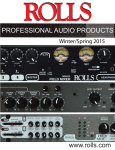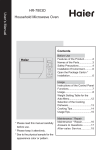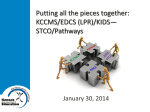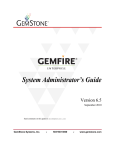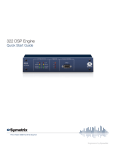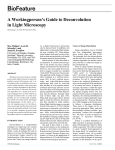Download AMX Distributed Audio Controllers Delta Series Specifications
Transcript
SymNet Applications Series
Audio Distribution G
Arenas and Stadiums • Casinos and
Gaming • Restaurants and Retail
Engineered by
www.SymetrixAudio.com
SymNet Application: Audio Distribution
6408 216th St. SW | Mountlake Terrace, WA 98043 | USA | Tel: +1 (425) 778.7728 | Fax: +1 (425) 778.7727
Contents
Introduction and Overview...............Page 1
SymNet Technologies for Audio
Distribution:
SPL Computer Modules................... Page 2
Gap Sensing..................................... Page 2
Continuous....................................... Page 3
SymNet Design for Audio Distribution:
Audio Distribution Design........... Page 4-6
Audio Distribution Control Screens
..................................................... Page 7-8
Diagrams:
Audio Distribution
Signal Flow............................... Pages 9-10
Audio Distribution
System Diagram..................... Pages 11-12
H Featured Products:
ARC-2 Adaptive Remote Control.............13
ARC-PS Rack Mount Wall Panel
Power Supply..................................Page 14
SymNet Express 12x4 Cobra.... Page 15-16
Featured Article:
Quinault Beach Resort
and Casino.............................. Pages 17-18
www.SymetrixAudio.com
SymNet Application: Audio Distribution
Arenas and Stadiums • Casinos and Gaming • Restaurants and Retail
Introduction
Overview
Audio Distribution systems are the backbone of any
hospitality or entertainment venue including casinos,
restaurants, hotels, retail spaces, and sports arenas.
Their purpose is to distribute audio to various zones
(areas or rooms) throughout the facility. Audio content
typically consists of background music (BGM), paging,
or other audio sources such as a sports announcer,
advertisements, or jingles. Thus, the purpose of an audio
distribution system is often two fold: to provide ambience
and to provide information. Noise masking systems used
in office environments are another example of a more
specialized audio distribution system that's purpose is to
provide a level of privacy in an open floor plan.
Picture a small restaurant with a dining area, a bar, a
lobby and a seating area outside the building to accommodate waiting guests. Each area is considered a
zone. Microphones and a collection of background music
sources connect to the SymNet system, which shapes and
routes the signals to the zones.
SymNet™ Audio Distribution systems are the most
powerful and flexible, yet easiest to use in the industry.
Its toolkit contains all of the desired modules for any
routing situation, from selectors and distributors to
matrix mixers and priority-driven routers. The flexible
bussing architecture handles a range of systems, from
those requiring a large centralized I/O schema, to systems
requiring smaller clumps of distributed I/O – to anything
in between. User control may be tailored specifically for
the client using intuitive wall panels with tactile buttons,
knobs and customized text menus.
Now imagine the restaurant is filling up with customers
and a low roar fills the room. Through SymNet technology, the music and the paging audio are still audible
over the crowd as if someone turned up the volume to
compensate. But these audio systems typically operate
hands-free with minimal amount of human interaction.
Often, wall panels are installed throughout the facility
to provide simple adjustments when necessary, but is
someone really standing by and adjusting the audio level
whenever the room fills or empties? The short answer
is, no. The adjustment is made automatically by the
SymNet system.
“Fritz, party of four, your table is ready…” The staff needs
a paging system to make announcements into particular
areas. The paging system usually shares the speakers
with the music system. The announcements “duck” or
reduce the volume of the audio currently playing in the
zone so the announcement is heard clearly, and of course,
SymNet does this automatically.
6408 216th St. SW | Mountlake Terrace, WA 98043 | USA | Tel: +1 (425) 778.7728 | Fax: +1 (425) 778.7727
1
Page
SymNet Technologies for Audio
Distribution
As mentioned earlier, SymNet’s toolkit has a full
complement of routing, mixing and matrixing modules.
However, several of its audio processing modules are of
particular use in audio distribution systems.
AGC (Automatic Gain Control) modules are invaluable
for controlling the sometimes wildly varying levels of
background music sources. The British EQ combines the
most popular filters and equalization used in microphone
processing. When combined with a Compressor/Limiter,
triggering a Ducker, you’ll have a foolproof paging signal
chain that simply sounds great.
In certain situations an audio distribution system must
perform tasks at specific times. SymNet accommodates
this by scheduling a preset recall on a calendar. Using the
Event Scheduler in SymNet Designer, the integrator can
setup any stored preset to be recalled at a specified time.
Recurring, or exclusive, special events are easily
accomplished as well.
A sensing microphone is mounted in the zone to monitor
the ambient noise level within that zone. Typically, one
SPL Computer and microphone are required for each zone
where ambient noise compensation is desired.
As more people are added to the zone the room volume
increases; the SPL Computer module turns up the volume
within the zone to maintain the proper balance of ambient noise and sound system volume. As the room empties
(reducing the ambient noise level), the SPL Computer
turns the sound system down to an appropriate level. In
SymNet Designer, there are two types of SPL Computer
modules: ‘Gap Sensing’ and ‘Continuous’. Both types use
a microphone to monitor the ambient level in the room,
but they differ in how they perform the measurement.
G SPL Computer Modules: Gap-sensing
By far the most invaluable and unique process SymNet
has to contribute to the performance of audio distribution
systems are the SPL Computer modules. Their discussion
follows as the featured technology for this application.
G SPL Computer Modules
SymNet Gap-sensing SPL Computer module
SymNet SPL Computer Diagram
Sometimes referred to as Ambient Noise Compensation
modules, SPL Computers use a microphone to sense
the level of ambient (crowd) noise in a room, then automatically adjust the volume of the sound system within
predetermined parameters. Following the success of its
stand alone SPL Computers (the 571/572 and 371/372),
Symetrix has incorporated the technology into SymNet
by developing SPL Computer DSP modules for
SymNet Designer.
To take a measurement of the ambient noise, the Gapsensing SPL Computer either waits for the audio playing
in the zone to stop or fall below a certain threshold.
Once the audio has fallen beneath the threshold, the SPL
Computer mutes the zone audio and takes a reading of
the room. Based on the measured level, the volume is adjusted then the audio is un-muted. The level in the zone
will then be appropriate. If there are no gaps in the audio,
the system will momentarily mute the audio at specified
intervals to take its reading.
This type of SPL Computer module often produces better
results than a continuously sensing version as it does
not have to extrapolate its own output from the ambient
noise. Therefore, it can be more accurate and predictable
in certain situations as well as more forgiving to non-
www.SymetrixAudio.com
2
Page
SymNet Application: Audio Distribution
ideal setup. However, it may not be the most suitable for
situations requiring constant background program material
as the module does require a break in program material
to take its sense readings, or it must interrupt the program
material briefly.
G SPL Computer Modules: Continuous
As the name suggests, the Continuous SPL Computer is
reading the ambient noise in the zone at all times and
making adjustments immediately, as necessary. This
makes the setup of a Continuous SPL Computer a bit more
complex than the Gap-sensing version. Because the SPL
Computer is continuously monitoring, or listening, to the
noise level in the room, it will also be measuring some of
the audio from the sound system. The SPL Computer must
“remove” the system audio from its measurement to accurately measure only the ambient noise. This requires the
SPL Computer to be calibrated. Once the SPL Computer has
been calibrated, it can essentially ignore the system audio,
allowing it to continuously adjust the level of the sound
system.
The Continuous SPL Computer does require a little more
care to implement. Some consideration must be made
towards microphone type, microphone and speaker placement, DSP design (signal flow), and gain staging before
and after the SPL Computer module. The details of implementation, and much more, are fully documented within
SymNet Designer’s expansive help file.
6408 216th St. SW | Mountlake Terrace, WA 98043 | USA | Tel: +1 (425) 778.7728 | Fax: +1 (425) 778.7727
3
Page
Site File Configuration View
G SymNet Design for Audio Distribution
We are going to explore an audio distribution design
representative of a typical casino. It illustrates the use of
various background music and paging sources distributed
to four zones with SPL Computers.
Four sensing microphones, four background music/media
sources and four paging sources connect to the inputs of
a SymNet Express 12x4 Cobra. Routing and signal process-
ing is handled completely within SymNet before the audio
is sent to the outputs.
ARC-2 Adaptive Remote Control Wall Panels connect to
an ARC-PS which connects to the Express hardware via
RS-485, as shown in the above sample hookup diagram.
These wall panels control the music selection and volume
for a given zone.
This System Diagram depicts the overall layout of an
audio distribution design.
www.SymetrixAudio.com
4
Page
SymNet Application: Audio Distribution
SymNet Designer Site File
G Audio Distribution Design
Using SymNet Designer, open the first example Site File.
Then, double-click on the Express 12x4 Cobra in the Configuration Screen to view the Design Screen. Audio enters
the Analog Ins, feeding the initial gain stage. Proper gain
staging is a must for a well-behaved system and signal
levels should average around -20 dBFS on the meters.
!Mix Super-module: Next, the audio routes through the Mix
Super-module. This stage provides four bands of EQ for each
microphone input and the main faders for all channels. All
twelve channels exit the Super-module twice; once pre fade,
or before the main faders, and once post fade, or after the
main faders. A Mix output provides a single channel of post
fader mixed audio.
@Paging Super-module: This Super-module contains the
paging logic for each zone. For more information on SymNet’s paging technologies, please review the Public Address
application.
#Select Matrix Super-module: This Super-module provides
the ability to select any of the microphone or BGM inputs as
program material. Paging microphones are not available as
a selectable source. Two outputs for each zone feed the Zone
Routing Super-module.
$Zone 1-4 Super-modules: These Super-modules create a
mix for the zone output. Each Super-module has two program inputs, an aux mix input, and a page microphone input.
Zones 1 and 2, detailed later, also feature an SPL Computer.
%Output Super-module: Fed by each of the Zone Supermodules, this Super-module provides a matrix module which
allows custom routing of any zone to any output. Loudspeaker Management modules, Gain and Metering complete
this Super-module.
^Aux Mix Matrix: Additionally, there is a Matrix Mixermodule that follows the Mix Super-module which is used to
create unique mixes of the inputs for each zone.
6408 216th St. SW | Mountlake Terrace, WA 98043 | USA | Tel: +1 (425) 778.7728 | Fax: +1 (425) 778.7727
5
Page
The Zone Super-modules create the mix for each
zone. Program 1 and the Aux Mix connect to an Input
Selector module to choose the primary audio source
for the zone. The output feeds the primary input of
the first Ducker module. The side-chain input for this
Ducker is the Program 2 input. This allows Program
2 audio (when present) to duck Program 1 audio. A
Mixer module is used to mix the Program 1 and 2 audio, which then feeds the input of the second Ducker
module. The side-chain for this Ducker is the Paging
signal. This allows an incoming page to duck (override) either the Program 1 or 2 audio. Another mixer is
used to feed the SPL Computer modules in Zones 1 and
2. The SPL Computer modules are the Gap–sensing
type. The required Sense Input is connected to a microphone that monitors the zone. Zones 3 and 4 do not
have SPL Computers.
Zone 1-4 Super Module Design View
www.SymetrixAudio.com
6
Page
SymNet Application: Audio Distribution
G Audio Distribution Control Screens
Mix Control Screen:
Main Control Screen:
There is a “Main” button on the Configuration and Design
Screens linking to the Control Screen section. The Main
Control Screen displays the I/O for the system from left to
right and acts as the primary navigation page to view the
other Control Screens.
The Mix Control Screen meters the input audio before the
fader stage. There are mutes and faders for every channel
coming into the DSP device. Channels 1-4 also have EQ
buttons that open the EQ module. An ON button engages
the EQ. The Link buttons connect the volume and mute
controls for adjacent channels.
Zone Super-module:
Input Control Screen:
The Input Control Screen sets the initial gain for the audio
signals. Phantom Power can also be turned on or off.
The gain buttons should be used to “rough in” the input
gain. These buttons function as an analog gain adjustment. Adjusting the input gain in the analog domain helps
maximize signal to noise ratio and A/D converter resolution. The faders fine tune the input gain in the digital
domain. At the input stage, audio signals should average
around -20 dBFS. Furthermore, the input gain should
never be set so high that the system peaks or clips.
This is the Super-module Control Screen for the Zone
Super-modules. Organized by inputs, each section has
Fader and Mute controls plus other controls as applicable.
Program 1 and 2 also has controls for Input selection,
button links to the Ducker modules, and for Program 1,
selection between the Program Selection and a custom
Zone Mix. The Zone Out section of the Control Screen also
has a button link to the SPL Computer module on Zones 1
and 2. Metering for each input is also provided.
6408 216th St. SW | Mountlake Terrace, WA 98043 | USA | Tel: +1 (425) 778.7728 | Fax: +1 (425) 778.7727
7
Page
Output Control Screen:
The Output Control
Screen contains the
main zone faders, which
are a duplication of
the faders on the Zone
Routing Control Screen.
There are 4 output faders, mutes, and meters
along the bottom of the
screen. The matrix allows mixing of any zone
to any outputs. This
provides flexibility when a single zone feeds a multi-way
speaker system, for example. There are 4 SPK button links
that open SymNet’s Loudspeaker Manager modules which
control the crossovers (filters), EQ and delay settings for
each output. Finally, an ON button engages the EQ.
www.SymetrixAudio.com
8
Page
SymNet Application: Audio Distribution
Audio Distribution Signal Flow
Digi Trim
MIC 1
Gain Set /
Invert
Mute
3 Band
EQ
MIC 1
Mute
3 Band
EQ
MIC 2
Mute
3 Band
EQ
MIC 3
Mute
3 Band
EQ
MIC 4
48v
Digi Trim
MIC 2
Gain Set /
Invert
48v
Digi Trim
MIC 3
Gain Set /
Invert
ZONE MIX
OUT 1
48v
Digi Trim
MIC 4
Gain Set /
Invert
ZONE
MIX
MATRIX
48v
Digi Trim
BGM 1
BGM 2
Gain Set /
Invert
Mute
ZONE MIX
OUT 2
BGM 1
ZONE MIX
OUT 3
BGM 2
ZONE MIX
OUT 4
Digi Trim
Gain Set /
Invert
Mute
Digi Trim
BGM 3
Gain Set /
Invert
Mute
BGM 3
Digi Trim
BGM 4
Gain Set /
Invert
Mute
BGM 4
Digi Trim
PAGE 1
Gain Set /
Invert
Mute
2
Digi Trim
PAGE 2
3
Gain Set /
Invert
Mute
Digi Trim
PAGE 3
Gain Set /
Invert
Gain Set /
Invert
4
5
Mute
6
7
Digi Trim
PAGE 4
1
8
Mute
MIC 1
ZONE 1
PROG1
MIC 2
ZONE 1
PROG 2
ZONE 1
SPL
MIC 3
ZONE 2
PROG 1
MIC 4
BGM 1
SELECT
MATRIX
BGM 2
ZONE 2
PROG 2
ZONE 2
SPL
ZONE 3
PROG 1
BGM 3
ZONE 3
PROG 2
BGM 4
ZONE 4
PROG 1
MAIN MIX
ZONE 4
PROG 2
MAIN FADERS
9
10
11
12
ZONE 1
PAGE 1
PAGE 2
PAGE 3
PAGE 4
PAGE
LOGIC
ZONE 2
ZONE 3
ZONE 4
6408 216th St. SW | Mountlake Terrace, WA 98043 | USA | Tel: +1 (425) 778.7728 | Fax: +1 (425) 778.7727
9
Page
ZONE MIX 1
Program 1
Ducker 1
SIDECHAIN
Speaker Manager
Volume
Zone Mix.1
Ducker 2
SPL
Computer
Zones 1 &
2 only
1
1
Gain
Mute
Delay
HPF
LPF
OUTPUT 1
8 Band
Parametric
EQ
Inv.
8 Band
Parametric
EQ
Inv.
8 Band
Parametric
EQ
Inv.
8 Band
Parametric
EQ
Inv.
SIDECHAIN
Prog.2
Page
SPL
ZONE MIX 2
Program 1
Ducker 1
Ducker 2
SIDECHAIN
Speaker Manager
Volume
Zone Mix 2
SPL
Computer
Zones 1 &
2 only
2
2
Gain
Mute
Delay
HPF
LPF
OUTPUT 2
SIDECHAIN
Prog.2
Page
SPL
Matrix
ZONE MIX 3
Zone Mix 3
Program 1
Ducker 1
SIDECHAIN
Speaker Manager
Volume
3
Ducker 2
3
Gain
Mute
Delay
HPF
LPF
OUTPUT 3
SIDECHAIN
Prog.2
Page
ZONE MIX 4
Zone Mix 4
Program 1
Ducker 1
SIDECHAIN
Ducker 2
Speaker Manager
Volume
4
4
Gain
Mute
Delay
HPF
LPF
OUTPUT 4
SIDECHAIN
Prog.2
Page
www.SymetrixAudio.com
10
Page
SymNet Application: Audio Distribution
Audio Distribution System Diagram
BGM Sources in
Amp/SymNet Rack
SIGNAL
OK
POWER
SIGNAL
OK
POWER
Mic/Line
Inputs 9-12
Mic/Line
Inputs 5-8
Express 12x4
Cobra
in Amp/SymNet Rack
Mic/Line
Inputs 1-2
CAT 5
Mic/Line
Inputs 3-4
Host Computer
running SymNet Designer
SymNet Equipment List:
• 1 x Express 12x4 Cobra
• 1 x ARC-PS
• 4 x ARC-XLR
• 2 x MS-1
Amp In 1-2
Amp In 3-4
6408 216th St. SW | Mountlake Terrace, WA 98043 | USA | Tel: +1 (425) 778.7728 | Fax: +1 (425) 778.7727
11
Page
ARC-PS
in Amp/SymNet Rack
ARC-XLR
Page Station 4
ARC-XLR
Page Station 2
MENS
WOMENS
CAT 5
MENS
WOMENS
2
4
4
CAT 5
Amp/SymNet
Rack Room
SPL Computer
Sense Mics 1&2
in Ceiling Mounted MS-1s
CAT 5
XLR #2
MS -1
MS -1
1
ARC-XLR
Page Station 1
3
LOBBY BAR
XLR #1
CAT 5
1
2
Zone Out 1
Zone Out 2
Stereo Power
Amplifiers
in Amp/SymNet Rack
1
2
ARC-XLR
Page Station 3
Zone Out 3
Zone Out 4
www.SymetrixAudio.com
12
Page
ARC-2 Wall Panel
SymNet Application: Audio Distribution
ARC-2
Adaptive Remote Control Wall Panel
The ARC-2 is a menu-driven remote control for Symetrix DSPs such
as the 8x8 DSP, and the SymNet Express Cobra line (8x8, 12x4, 4x12
and 4x4). Tap into the full power of your system with twenty-four
(24) menus with up to sixteen (16) items each that can be used to address multiple basic functions or initiate complex logic-based control
events: gain, preset triggering, source selection, room combining
and more. The 8-character backlit display supports up to thirty-one
(31) scrolling characters, providing instant user feedback for control
assignments, default settings, and actions. The three buttons help
you navigate menus, raise or lower values, and enable or disable
the remote control. All control assignments, including item labeling,
parameter limits and firmware version upgrades are handled by
software included with Symetrix DSP hardware. Power, control, and
a single channel of ARC Audio are connected via RJ-45 inputs or
screw-type barrier strips. Intuitive Navigation: Pressing the menu
button navigates through the menu names. The menu button also acts
as a preset trigger when a preset list is scrolled. The up/down arrow
buttons adjust parameter settings and scroll through preset lists.
Holding the menu button and using the up/down arrow keys moves
you forward or backward through the menus. Programmable Setup:
The wall panel’s behavior is programmable as well. Menu brightness
in “active” and “inactive” states can be set independently, so the
display will “sleep” in light-sensitive environments like theaters. If
the ARC-2 goes idle, it can scroll a message and return to the top of
its menu tree. Upper and lower parameter limits help contain the
range of adjustment and a button press lockout will prevent tampering by curious but unauthorized fingers. Available with an aluminum
faceplate, ARC-2 mounts into a single gang electrical box (US).
Architect and Engineer Specifications: Adaptive Remote Control (ARC).
The series of remote control wall panels shall be designated in two groups – Menu ARC, and Modular ARC. The Menu ARC (ARC-2) shall include one 8-character backlit
alpha-numeric display, one momentary button for menu selection, and two momentary buttons for value increment/decrement. The Menu ARC shall mount in a standard U.S.
single-gang backbox. Power and control shall be connected via two RJ-45 connectors, or screw-type barrier-strip. Modular ARC wall panels shall consist of multiple models that
mount in standard U.S. single- or dual-gang backboxes, and shall be compatible with standard Decora® faceplates. ARC-K1 shall include one push-button rotary encoder, one
eight-segment LED stack, and two status LED indicators; ARC-SW4 shall include four momentary buttons with four corresponding status LED indicators; ARC-EXK shall include
one push-button rotary encoder, one eight-segment LED stack, and two status LED indicators, ARC-EX4 shall include four momentary buttons with four corresponding status
LED indicators; ARC-SWK shall consist of one ARC-K1 tied to one ARC-EX4. ARC-Mic shall include one onboard electret condenser microphone and one momentary push-to-talk
button, tied to one ARC-EX4; ARC-XLR shall include one 3-pin female XLR connector and one momentary push-to-talk button, tied to one ARC-EX4. Adaptive Remote Controls
shall function as external user controllers for Symetrix DSP systems. A designer software application shall be provided for assigning control within DSP system components.
RS-485 communications shall be utilized for software control and configuration. The series of wall panels shall be CE marked, CSA tested to UL 60065. The series of wall panels
shall be Adaptive Remote Control (ARC).
6408 216th St. SW | Mountlake Terrace, WA 98043 | USA | Tel: +1 (425) 778.7728 | Fax: +1 (425) 778.7727
13
Page
ARC-PS Power Supply
ARC-PS
Specifications
Rack Mount Wall Panel Power Supply
The ARC-PS is a nineteen (19) inch rack-mountable power supply capable of supplying power and control over CAT5 cable to a maximum
of ten ARC Wall Panels. Panels can be connected in a “star” configuration, “daisy-chain”, or a hybrid of the two. RS-485 from a DSP
device is connected to the ARC-PS Euroblock connector. The device
includes eight (8) RJ-45 connectors for CAT5 cable, and corresponding
Euroblock connectors for eight (8) discrete channels of ARC Audio.
! Main Power: Accepts power from Symetrix PS-4 (included) power
supply only (100-240 VAC, 50-60 Hz, 15 VDC output, 20 Watts max).
@ RS-485: Connects the SymNet system’s RS-485 bus, wired in parallel
(A to A, B to B and GND to GND) using shielded twisted pair.
GENERAL SPECIFICATIONS
RS-485 serial I/O
Data pass-through wired in parallel with
STP cable.
ARC Cable
Standard CAT5, distance dependent
upon load.
ARC output voltage
15 VDC (dependent upon power supply)
ARC maximum output current
1.3 A per port, 1.3 A total
# Remote ARCs (x8): Distributes power and RS-485 data to one or more
ARC devices.
$ ARC Audio (x8): Splits a single analog line level audio signal off of the
ARC port. Can be wired to a line level analog input or output jack for
remote audio over CAT5.
Mechanical Data
Item
Specifications
Remarks
Space Required
1U (WDH: 48.3 cm x 10.2 cm x 4.37 cm / 19 in x 4.0 in x
1.72 in). Depth does not include connector allowance.
Allow at least 1 inch additional clearance for rear panel connections. Additional depth
may be required depending upon your specific wiring and connections.
Electrical
100-240 VAC, 50-60 Hz, 15 VDC output, 20 Watts
maximum.
No line voltage switching required.
Ventilation
Maximum recommended ambient operating temperature is 30 C / 86 F.
The ventilation should not be impeded by covering the ventilation openings with items
such as newspapers, tablecloths, curtains, etc.
Shipping Weight
2.0 kg (4.4 lbs.)
Architect and Engineer Specifications: SymNet ARC-PS.
The ninteen inch rack-mount wall panel power supply shall provide eight ARC ports on RJ-45 connectors, eight ARC Audio ports on plug-in barrier-strip connectors, and RS-485
interface on one plug-in barrier-strip connector. The device shall function as a power supply and RS-485 data router for SymNet ARC wall panels. The rack-mount wall panel
power supply shall be CE marked, CSA tested to UL 60065.
The rack-mount wall panel power supply shall be ARC-PS.
www.SymetrixAudio.com
14
Page
SymNet Application: Audio Distribution
DSP Hardware
Express 12 x 4 Cobra
Express Cobra
SymNet Express Cobra is a family of 19 ” rack-mountable digital signal
processors (DSP) that are setup and controlled by SymNet Designer
software. They are ideal for audio applications such as churches, conference rooms, courtrooms, night clubs and many others. ARC Wall
Panels easily integrate with Express hardware and provide simple
user control of the system.
There are four analog I/O options available for the Express line:
12x4, 4x12, 8x8, and 4x4. Express devices also employ the industrystandard CobraNet® technology to share audio between devices
supporting 16 inputs and 16 outputs of CobraNet audio over
Ethernet in addition to the analog I/O. Express devices are intended
for single device installations as well as installations with modest
expansion requirements.
Devices are initially configured through the RS-232 port on the rear
panel. This same port is used to connect to external control systems
from AMX, Crestron, and others. Once the system is initially configured, Express devices can be addressed and controlled over Ethernet.
Any of the ARC Wall Panels can be connected via CAT5 cable to an
RJ-45 jack on the rear panel. One channel of analog audio can be
routed to or from the wall panel over the CAT5 cable for simple paging or monitoring needs. Express also includes an RS-485 port for
extending the ARC and external control capacity.
Specifications
GENERAL SPECIFICATIONS
AUDIO SPECIFICATIONS
Processors
2 x Analog Devices SHARC 21161N @
100 MHz SIMD
Converter Type
24-bit Sigma Delta
Raw processing capacity
200 MIPS, 800 MFLOPS sustained
Sampling Rate
48 kHz, +/- 100 ppm
Analog control inputs
0-5 VDC
Frequency Response
20-20 kHz, +/- 0.5 dB
Recommended external control potentiometer
10k Ohm, linear
A/D dynamic range
> 110 dB, A-weighted
RS-232 host serial I/O
115.2 or 57.6 kbaud, 8 data bits, 1 stop
bit, no parity, no flow control wired
straight-through, only pins 2, 3, and 5
required
D/A dynamic range
> 110 dB, A-weighted
RS-232 accessory serial I/O
38.4 kbaud (default), 8 data bits, 1 stop
bit, no parity, no flow control wired
straight-through, only pins 2, 3, and 5
required
Total THD+ Noise
< 0.005% @ 1 kHz, -1 dBFS
RS-485 serial I/O
38.4 kbaud (default) 8 data bits, 1 stop
bit, no parity, no flow control wired in
parallel with STP cable.
Delay memory
43 mono seconds
Ethernet/CobraNet Cable
Standard CAT5, maximum device to
device length = 100 meters
Input impedance
6.67k Ohms, balanced
ARC Cable
Standard CAT5, distance dependent
upon load.
Output impedance
204 Ohms, balanced
Maximum devices per SymLink Ring
1
Maximum input level
+29 dBu with 6 dB pad, +23 dBu w/o pad
Maximum SymLink Rings
31
Maximum output level
+24 dBu, 100k Ohms; +21 dBu. 600 Ohms
Maximum stored presets
1000
Mic preamp EIN
-129 dBu typical, 22-22 kHz, A-weighted
Phantom power (per input)
+48 VDC, 10 mA
Input CMR
> 70 dB @ 60 Hz
Channel separation
> 100 dB, in through out @ 1 kHz
6408 216th St. SW | Mountlake Terrace, WA 98043 | USA | Tel: +1 (425) 778.7728 | Fax: +1 (425) 778.7727
15
Page
! Main Power: Accepts power from detachable IEC power cable
(100-240 VAC, 50-60 Hz, 60 Watts max).
@ Aux Power: Accepts power from Symetrix model PS-7 or user-supplied
auxiliary power connection (24 VDC, 2.5 Amps, 60 Watts max).
# ARC Audio: Splits a single analog line level audio signal off of the
ARC port. Can be wired to a line level analog input or output jack for
remote audio over CAT5.
$ ARC: Distributes power and RS-485 data to one or more ARC devices.
% RS-485: Connects to a Control I/O, ARC-PS, ARC or other Symetrix
SymNet family RS-485 controller, wired in parallel (A to A, B to B and
GND to GND) using shielded twisted pair. Port Settings: 38.4 kbaud
(default), 8 data bits, 1 stop bit, no parity, no flow control.
^ RS-232: Serial communications interface for SymNet Designer on the
host PC or a 3rd party accessory controller. (Mode is determined by the
“RS-232: Host / Acc” mode switch.) Port Settings (Host): 115
or 57.6 kbaud, 8 data bits, 1 stop bit, no parity, no flow control. Port
Settings (Acc): 38.4 kbaud (default), 8 data bits, 1 stop bit, no parity,
no flow control.
& Device Config: Configures the RS-232 port mode, RS-232 port host
( CobraNet/Ethernet: 10/100 Base-T Ethernet port for CobraNet
audio, 16 send and 16 receive channels. (Future software versions
may support SymNet Designer host control over IP+CobraNet on this
same port.)
BL Relay Out: 1 SPDT relay rated at 3 Amps, 24 VDC, resistive; 0.3 Amps,
60 VDC, resistive and can be wired normally open or normally closed.
This relay can also be used for power failure detection or emergency
alarm system integration.
BM O/C Out: 2 open collector outputs with a paired common ground pin.
O/C outputs go low (0V) when active, and are internally pulled high
(5V) when inactive and can drive external LED indicators directly.
BN Control In: 2 analog control inputs able to be used as 2 potentiometer
inputs, 2 mechanical rotary encoder inputs, or as 4 switch inputs
(+5 VDC reference voltage supplied).
BO Analog Outputs: 4, 8 or 12 analog line level audio inputs with
individually software-selectable level of -10 dBV or +4 dBu.
BP Analog Inputs: 4, 8 or 12 analog mic / line level audio inputs with
individually software-selectable phantom power and level of -50 dBu,
-40 dBu, -20 dBu, -10 dBV or +4 dBu.
mode baud rate and Ring Number (device address).
* Ethernet: 10/100 Base-T Ethernet port for SymNet Designer host
control over IP. IP control must be setup from SymNet Designer via
RS-232 first for security.
Mechanical Data
Item
Specifications
Remarks
Space Required
1U (WDH: 48.3 cm x 27.4 cm x 4.37 cm / 19 in x 10.8 in x
1.72 in). Depth does not include connector allowance.
Allow at least 1 inch additional clearance for rear panel connections. Additional depth
may be required depending upon your specific wiring and connections.
Electrical
100 to 240 VAC, 50-60 Hz, 60W maximum.
No line voltage switching required.
Ventilation
Maximum recommended ambient operating temperature is 30 C / 86 F.
Fan on equipment right pulls hot air out of device. Air intake at equipment left. Ensure
that the left and right equipment sides are unobstructed (5.08 cm, 2 in minimum
clearance). The ventilation should not be impeded by covering the ventilation openings with items such as newspapers, tablecloths, curtains, etc.
Shipping Weight
6 kg (12 lbs.)
Architect and Engineer Specifications: SymNet Express Cobra.
The series of four DSP audio matrix devices shall include four different configurations of balanced mic/line inputs and balanced line outputs on plug-in barrier-strip connectors.
These configurations shall be 12x4, 4x12, 8x8, and 4x4. Each shall be offered with CobraNet compatibility. Additionally each device shall include two analog control inputs, one
open collector output, and one relay output on plug-in barrier-strip connectors, ARC interconnect on one RJ-45 connector, ARC Audio on one plug-in barrier strip connector, and
24 VDC backup power on one 4-pin male XLR connector. The devices shall include one RJ-45 connector for CobraNet network audio. Audio inputs and outputs shall be analog,
with internal 24-bit A/D & D/A converters operating at a sample rate of 48 kHz. All internal processing shall be digital (DSP). Software shall be provided for creating/ connecting
DSP system components within each hardware device. Available system components shall include (but not be limited to) various forms of: mixers, equalizers, filters, crossovers,
dynamics/gain controls, routers, delays, remote controls, meters, generators, onboard logic, and diagnostics. Ethernet or serial communications shall be utilized for software
control and configuration. After initial programming, processors may be controlled via dedicated software screens, third-party RS-232 control systems, and/or optional analog
or RS-485 remote control devices. A designer software application shall operate on a Windows computer, with network card installed, running Windows® 98/2000/XP. The DSP
series shall be CE marked, CSA tested to UL 60065.
The DSP series shall be SymNet Express Cobra.
www.SymetrixAudio.com
16
Page
Featured Article
SymNet Application: Audio Distribution
graphical area, we
got the call," said
Debbie Williamson,
director of sales
and marketing for
Tempest Technologies, LLC.
Tempest Controls Casino with
SymNet
Ocean Shores, Washington:
Over the last several decades, casinos across the country
have become much more than just a place to visit for a
day to play poker or slots. Today's casinos offer a total
experience, complete with on-site hotels, spa services,
live entertainment, special function halls and, of course,
the latest audio technologies.
When Quinault Beach Resort & Casino ("Casino") in Ocean
Shores, Washington needed to upgrade the processing
for their building-wide sound system, they turned to
Symetrix' SymNet Networked Audio Solution and the
design/build firm Tempest Technologies, LLC in nearby Issaquah, Washington (located in the greater Seattle area).
"The client had called Symetrix looking for a referral.
Since we are a reseller for Symetrix in the same geo-
The Casino was
looking to replace
its processing
system and mixers
that were installed
circa 1998 and
were no longer
supported by the
manufacturer.
Considering the
rapid pace of
audio technology
advancements, the
Casino wanted the
firm to look at their
audio wish list
once more with a
fresh eye to ensure
they were making
the proper decision. "Using our recommendation and
design process, we were happy to confirm that Symetrix
offered the perfect solution for their needs and budget,"
added Williamson.
The Tempest Technologies, LLC team chose Symetrix'
SymNet platform as a means to both maintain the current
functionality, as well as expand the Casino's audio capabilities. "Being analog, the old system was very manual,"
said Mark Scuka, director of applied technology for
Tempest Technologies, LLC. Scuka has completed training
with Symetrix and is well-versed in the SymNet product
line. "The Casino wanted more control points than before
and more automation of features.”
The audio processing includes 26 zones of audio across
the facility, including the main Casino floor, the Great Hall,
the Poker Room, the lobby, an indoor pool, the Grand
Entry, the Bistro and multiple other indoor and outdoor
public areas. For the Great Hall banquet rooms, there was
6408 216th St. SW | Mountlake Terrace, WA 98043 | USA | Tel: +1 (425) 778.7728 | Fax: +1 (425) 778.7727
17
Page
also the need to room combine, in any configuration, up
to six rooms. On top of that, the facility is open seven days
per week from 17 to 20 hours a day, so it was imperative
that the system was down for as little amount of time
as possible. As such, Scuka
took advantage of his ability
to complete the programming
upfront, prior to the installation
date. He added, "We installed
SymNet hardware mostly at
night during off-peak periods.
The system was down for less
than 48 hours total since the
program was designed and
tested in our office.”
To handle the Casino's current
and future requirements,
Tempest Technologies, LLC
installed three SymNet 8x8 DSP
boxes, along with three SymNet
BreakIn12 A/D input devices
and three SymNet BreakOut12
D/A output devices. Since the
BreakIn/Out boxes have no
DSP processing onboard, they
are a cost-effective option that
can take full advantage of the
processing power in the 8x8 DSP box.
Scuka noted, "The transition of analog to digital was very
easy for them. They wanted to be hands-off as much as
possible. Therefore, we gave them basic controls using
SymNet ARC-2 wall panels and AMX touch panels.”
The thirteen ARC-2 panels were connected in the same
places as the old wall plates, with a new CAT5 cable run
to each location. Using the new ARC-2 wall panels, the
Casino has access to up to 24 menu items, each with 16
sub-menu items - to functions like volume, preset recall,
and room combining. In addition, Tempest Technologies,
LLC also set the correct system limits so that a Casino
employee cannot accidentally max out the system and
send it into feedback. One SymNet ARC-MIC wall panel
with enclosed condenser microphone and two SymNet
ARC-PS rack-mount power
supplies for ARC wall panels
were also installed.
In the Casino games area,
visitors can play 350 electronic
gaming devices like slots
and electronic poker, 15 table
games, and Keno - all of
which can make for a challenging listening environment.
Scuka programmed the SymNet system using the ambient
noise compensation features
to ensure a harmonious balance between game playing
and paging or background
music. A microphone with
input to the SymNet system
was installed on the casino
floor to monitor the ambient
noise level and adjust the
sound system accordingly within preset levels. "Although
the microphone input checks SPL levels and adjusts the
system, the Casino also has individual control over each
zone," said Scuka.
The Casino also picked up the CobraLink option so
Tempest Technologies, LLC could remotely update the
programming, if necessary. "Any issues can be addressed
quickly rather than waiting for a service technician to arrive on-site," said Williamson. "Overall, this system is very
scalable so it can grow along with them."
www.SymetrixAudio.com
18
Page
19
Page
www.SymetrixAudio.com
www.SymetrixAudio.com
20
Page
SymNet Application: Audio Distribution
AL, GA, MS, NC, SC, TN
EDA Pro Group
Mark Adams [email protected]
2020 Westside Court, Suite C
Snellville, GA 30078
T: +1 (770) 985-2424 F: +1 (770) 985-2423
WY, CO, NM, UT, Billings MT
PEARSON & PEARSON MARKETING, INC.
John Pearson [email protected]
69520 E. Jewell Ave., Suite C
Denver, CO 80247
T: +1 (303) 306-6800 F: +1 (303) 306-6888
Upstate New York
EATON SALES & MARKETING
Charlie Eaton [email protected]
65 Main Street
Binghamton, NY 13905
T: +1 (800) 782-3670 F: +1 (607) 771-3439
AZ, S.CA, S.NV
ALLIANCE AUDIO GROUP
Matthew Jensen [email protected]
10754 Noel Street
Los Alamitos, CA 90720
T: +1 (714) 229-2056 F: +1 (714) 229-2059
New York Metro, Northern NJ
JOHN B. ANTHONY / METRO REPS
Mike Oltz [email protected]
16 Passaic Ave, #6
Fairfield, NJ 07004
T: +1 (973) 808-4188 F: +1 (973) 808-1055
IL, IN, MI, MN, WI, OH, ND, SD
STARIN MARKETING
Neal Weber www.starin.biz
136 Venturi Drive
Chesterton, IN 46304
T: +1 (317) 577-4290 F: +1 (219) 929-4377
AK, WA, Northern ID, Western MT, OR
LOPPNOW & ASSOCIATES
Jim Loppnow [email protected]
1420 NW Gilman Blvd. #2857
Issaquah, WA 98027
T: +1 (425) 392-3936 F: +1 (425) 392-3973
DC, DE, MD, S. NJ, PA, VA, WV
TOWLES MARKETING
Mark Towles [email protected]
8030-34 Main Street, 3rd Floor Front
Ellicott City, MD 21043
T: +1 (410) 465-7100 F: +1 (410) 465-7860
AR, LA, OK, TX
MARKETING CONCEPTS
Michael Austin [email protected]
2482 Southwell Road
Dallas, TX 75229
T: +1 (210) 732-3033 F: +1 (210) 732-3044
IA, KS, MO, NE, Southern IL
CADON TECHNICAL SALES
Michael Canning [email protected]
500 Haber Park Court, Suite 103
Weldon Spring, MO 63304
T: +1 (636) 300-3671 F: +1 (636) 300-3681
Florida
MICHAEL CHAFEE ENTERPRISES
Michael Chafee [email protected]
1891 Porter Lake Drive #104
Sarasota, FL 34240
T: +1 (941) 343-0775 F: +1 (941) 343-0772
Northern CA, Northern NV, Hawaii
TROUT FARM TECHNICAL SALES
John Hood [email protected]
4219 South Market Suite A
Sacramento, CA 95834
T: +1 (800) 480-8544 F: +1 (800) 408-2145
International Sales
Europe, Africa, Middle East
WORLD MARKETING
Francis Williams [email protected]
26 Penwinnick Road, St. Austell
Conrwall, PL25 5DS, UK
T: +44 (0) 1726 874184 F: +44 (0) 1726 874185
Asia
SYMETRIX – Asia Applications Specialist
Hock Thang [email protected]
1 Jalan Taman, Unit No: 10-05
Singapore 329022
T: +65 90091263
Asia, Australia, South Pacific, India
S~WAVE MARKETING
Kris Jackson [email protected]
1996 Valley Rim Road
El Cajon, CA 92019
T: +1 (619) 444-6060 F: +1 (619) 444-7070
Latin America, Caribbean
AUDIO AGENT
Dave Christenson [email protected]
155 108th Ave. NE, Suite 210
Bellevue, WA 98004
T: +1 (425) 605-0658
New England
NOREAST MARKETING
David Bierut [email protected]
119 Deerfield Road
Windsor, CT 06095
T: +1 (860) 285 0636 F: +1 (860) 285 0686
© 2008 Symetrix, Inc. All rights reserved. Printed in the United States of America. Symetrix Part Number 53SNA1-0A01. The information in this document is subject to
change without notice. Symetrix, Inc. shall not be liable for technical or editorial errors or omissions contained herein; nor is it liable for incidental or consequential
damages resulting from the furnishing, performance, or use of this material. Mention of third-party products is for informational purposes only and constitutes neither
an endorsement nor a recommendation. Symetrix assumes no responsibility with regard to the performance or use of these products. Under copyright laws, no part of
this brochure may be reproduced or transmitted in any form or by any means, electronic or mechanical, without permission in writing from Symetrix, Inc. If, however,
your only means of access is electronic, permission to print one copy is hereby granted. The following are either Trademarks or Registered Trademarks of Symetrix, Inc.:
Symetrix, SymNet, SymNet Designer, SymLink, and CobraLink. Windows is a Registered Trademark of Microsoft, Inc.. Other product names mentioned herein may be
trademarks and/or registered trademarks of other companies and are property of their respective owners.
Engineered by
6408 216th St. SW | Mountlake Terrace, WA 98043 | USA | Tel: +1 (425) 778.7728 | Fax: +1 (425) 778.7727
21
Page

























